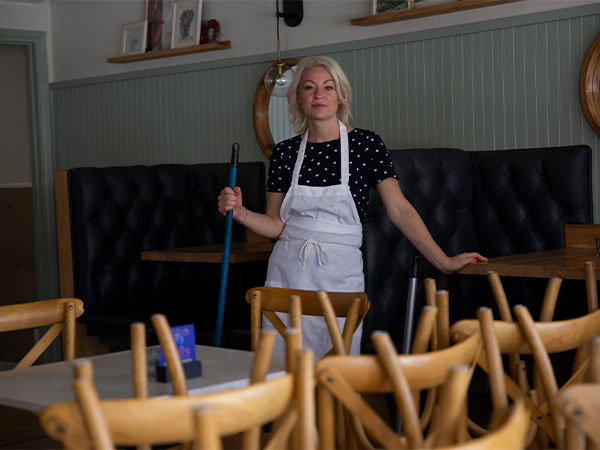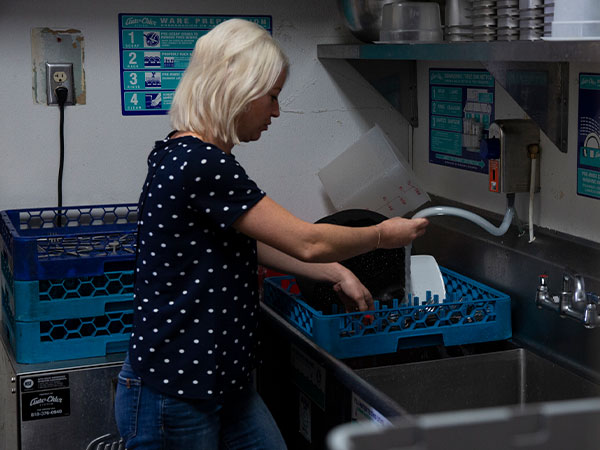

“I never thought I would end up in the kitchen,” Rebecca Rose Phillips says. But on a humid August morning, that’s exactly where the certified sommelier is, prepping taco meat for that night’s Taco Tuesday special. As wine and beverage director of Vintage Wine + Eats in Studio City, California, this wasn’t originally part of her job, but she’s still smiling. Unusual? Perhaps. But it’s increasingly common as restaurants decide whether to stick with conventional business models or try something totally new.
In March, 2020, Phillips had to lay off her entire staff when the initial shutdowns hit. When she finally got the green light to reopen in April, 2021, Phillips knew that the only way the wine bar could operate on reduced sales was with a skeleton crew. Her plan? She hired a team of sommeliers, streamlined the kitchen, and trained everyone to work in both the front and the back of the house. Today, everyone on her crew is not only a sommelier, but a dishwasher, a line cook, and a toilet scrubber.
“My business partners said I would never get a somm to do dishes,” Phillips laughs. She not only got one, but six. To encourage them, she had to radically change the tip structure so that, no matter what position each staff member worked, the pay evened out. Today, the front-of-house server makes the same as the dishwasher.
For many restaurateurs struggling through COVID times, staffing has become a major dilemma, and some are reconsidering the role of sommeliers. Pre-pandemic, San Francisco’s Epic Steak had a team of four sommeliers whose primary duty was to sell wine; they received tips from the servers on a daily basis. This practice was eliminated when they returned to work in June, 2020.
Sommelier 2.0
A comparison of sommelier tasks pre– and post–restaurant closures
1.0 2.0 Duties
✔ ✔ Knowledge of wine list
✔ ✔ Sell and pour wines
✔ ✔ Polish glassware
✔ ✔ Set up by-the-glass station
✔ ✔ Pair food with wine
✔ ✔ Wine education for staff
✘ ✔ Set tables for service
✘ ✔ Server duties
✘ ✔ Floor-manager duties
✘ ✔ Line cook
✘ ✔ Dishwasher
✘ ✔ Research/order food
✘ ✔ Run food
Today, the steakhouse runs with a team of one, Grace Newport, who primarily manages the restaurant floor, selling wine only when she can. She also runs the team of bartenders, manages the schedule, and trains the rest of the staff. Without any alternative compensation, Newport had to take a pay cut to help the restaurant survive.
Still, many restaurants have held to something close to their pre-pandemic model. At Otium, in downtown Los Angeles, sommeliers perform the same roles as they always have. “I worked hard to keep employees from doing tasks or jobs other than those for which they were hired,” beverage director Andrew Pettingell attests. But even though the duties and tip structure remain the same, the restaurant is open just five days a week instead of its usual seven. This means fewer shifts for sommeliers. Some have picked up serving shifts. Others, in response to similar cutbacks across the country, have reconsidered their career choice.
Will Marengo worked as a sommelier at Manhattan’s Greek fine dining restaurant, Nerai, prior to the pandemic. Yet by 2021, he was in a similar situation as Newport of Epic Steak. “At first, I was just happy to be back in action after three months of stagnation,” Marengo said. But he soon became disenchanted and decided to move on. Marengo is now pursuing a degree in enology and viticulture at Walla Walla Community College in Washington State, hoping to make wine.


As more sommeliers explore alternative career paths, restaurants are scrambling to fill open positions. Meanwhile, at Phillips’ Vintage Wine + Eats, “It feels more like a family than anywhere else I’ve worked,” Josh Cherny says. A staff member who previously ran the food and beverage program at Yosemite Curry Village, he’s working behind the bar the day we talk. And each day brings a different task—Cherny recalls having to plunge a clogged sink in the middle of service. “It gets hectic for sure,” he says, “but I would rather that than work a slow-paced job where I sit back and do nothing.”
Susanne Peeters, another member of the Vintage Wine + Eats staff, echoes Cherny’s sentiments. Peeters, previously at Wally’s Wine in Santa Monica, had always wanted to work in the kitchen, but, having relied on tips for the majority of her career, she feared the straight hourly pay that came with the position. The structure at Vintage Wine + Eats offered her the best of both worlds. “Personally, I like the new structure,” she tells me. “But it takes a certain type of personality to work both front and back of house.” Neither Peeters nor Cherny is afraid to get their hands dirty; both have worked crush at wineries—Peeters at Pulchella and Cherny at Quintessa.
Still, as business has been growing, Phillips is planning to hire a cleaning crew in September. As for the rest of the system, for now, it’s here to stay.
Based in Los Angeles, California, Alissa Bica is the Associate Editor and Spirits Critic at Wine & Spirits. She is also a sommelier at 71 Above and co-runs the home wine tasting company, Côte Brune and Blonde. In any rare moments of free time, she writes about obscure grape varieties in the blog Off the Beaten Wine Path.
This story appears in the print issue of October 2021.
Like what you read? Subscribe today.

















